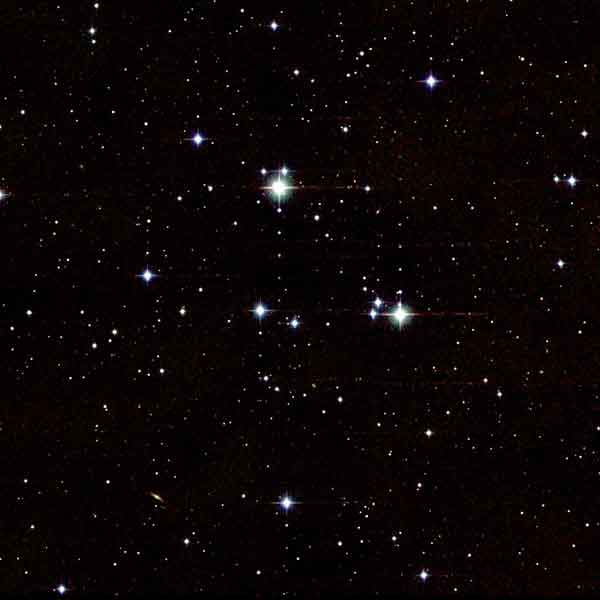- ^ Frommert, Hartmut (1998). "Messier Questions & Answers". Retrieved March 1, 2005.
- ^ M44, Students for the Exploration and Development of Space, February 6, 2005.
The Beehive Cluster is an open cluster in Cancer just visible to the naked eye. Atlas Image [or Atlas Image mosaic] obtained as part of the Two Micron All Sky Survey (2MASS), a joint project of the University of Massachusetts and the Infrared Processing and Analysis Center/California Institute of Technology, funded by the National Aeronautics and Space Administration and the National Science Foundation.
The Beehive Cluster (also known as Praesepe (Latin for "manger"), M44 or NGC 2632) is an open cluster in the constellation Cancer. It looks like a nebulous object to the naked eye under dark skies, and thus has been known since ancient times--Ptolemy called it "The nebulous mass in the breast" of Cancer. It is also among the first objects Galileo studied with his telescope. The 730-million-year old cluster is 577 light years away. Its age and proper motion coincide with the Hyades open cluster, suggesting they were created in the same diffuse nebula. Both contain red giants and white dwarfs, but the brightest stars are class A, F, and G stars. It contains at least 200 stars, and perhaps as many as 350. The Beehive is most easily observed when Cancer is high in the sky; this occurs during the evening from February to May. At 95 arc minutes across, it fits well in the field of view of binoculars or a telescope of low power.
History Galileo was the first to observe the Beehive in a telescope, in 1609, and was able to resolve it into 40 stars. Charles Messier added it to his famous catalog in 1769 after precisely measuring its position in the sky. Along with the Orion Nebula and the Pleiades cluster, Messier's inclusion of the Beehive has been noted as curious, as most of Messier's objects were much fainter and more easily confused with comets. One possibility is that Messier simply wanted to have a larger catalog than his scientific rival Lacaille, whose 1755 catalog contained 42 objects, and so he added some bright, well-known objects to boost his list[1] Ancient Greeks and Romans saw this nebulous object as a manger with two donkeys, the stars Asellus Borealis and Asellus Australis, eating from it, specifically, the donkeys that Dionysos and Silenus rode into battle against the Titans.[2] This perceived nebular object is the main celestial object in the 23rd lunar mansion (Hsiu Kuei or Xiu Gui) of ancient Chinese astrology. Ancient Chinese skywatchers saw this as a ghost or demon riding in a carriage and likened its appearance to a 'cloud of pollen blown from willow catkins'. Composition The cluster is about 16 light years in diameter and contains at least 200 stars confirmed to be bound to the cluster, out of 350 total in the vicinity. It has a visual brightness of magnitude 3.7. Its brightest stars are blue-white and of magnitude 6 to 6.5. The Beehive is one of the older and larger open clusters known. 42 Cancri is a member of this cluster. References Links Retrieved from "http://en.wikipedia.org/"

|
|
||||||||||||||||||||||||||||||||||
